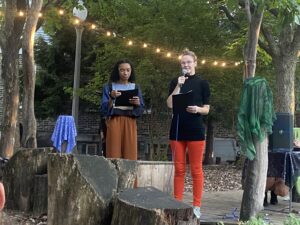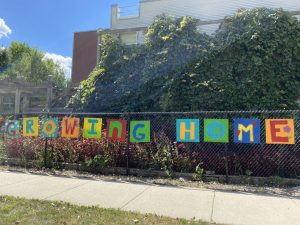For the past two years, every April through September, 63 year-old Carlos Nunez, has been waking up early morning to go water his plants, monitor the garden for about two to four hours and returns after sunset to do it all again. Nunez, a Pilsen resident, is a volunteer garden monitor for the Growing Station Community Garden, which is located on the 2100 block of West Sangamon St. in the Pilsen neighborhood.
“It’s important for me to be over there,” Nunez said. “It helps relieve my stress, and it’s important for our community and environment.”

(Photo by: Priscilla Lopez)
As his part in the effort to conserve water, Nunez does his watering in the early morning and in the evening because water evaporates less during those times.
In 2012, the City of Chicago reformed the fee waiver system by charging community gardens for hydrant water.
“Alivio Medical Center and Casa Maravilla have completely been supporting us with water, they have given us access to their water since April 2009, which is when the garden started,” said Sallie Gordon, one of the founders of Growing Station Community Garden, “Casa Morales, which is managed by Resurrection Project, also supply us with water.”
Gordon emphasized the fact that the problem is water waste, and it’s becoming a serious issue.
“The garden’s main focus this upcoming fifth season is water conservation,” Gordon said.
Due to her water conservation efforts in the Growing Station Community Garden, Gordon was invited to attend a community garden conference on Feb 23. Connecting Chicago Gardening Communities provides workshops for community garden leaders.
“I gave a brief presentation on water conservation, over 200 people showed up,” Gordon said, “It was an amazing event.”
According to Gordon, the 2012 season was the most successful year for Growing Station because a lot more people from the community started getting involved, especially families from Casa Morelos and seniors from Casa Maravilla.
“In 2010 I applied for Greencorps grant, I had to attend workshops to earn the money,” Gordon said, “The first year we got 3 cedar beds, a tree and tools, following year we were able to expand, they installed more cedar beds and brought soil, without that program we wouldn’t have been able to expand within the year.”
During 2012 Greencorps has not been able to continue the community garden grant program.
Other not-for-profit organizations have helped the Growing Station Community Garden. Neighborspace donated a new wooden fence and tool shed. Openlands donated milk weed plants.
One of the garden leaders Antonio Acevedo, built and helped install a solar panel in the garden that powers the self-watering buckets that are used to harvest rain water.
“We have self watering buckets, they are basically hydroponic buckets, each bucket is dedicated to one plant, and all buckets are connected to one big reservoir of water,” said Acevedo, who holds a bachelor’s in civil engineering from University of Illinois at Chicago, “No manual watering is required for that system as long as the reservoir is full, and hopefully the rain can take care of that.”
As part of Acevedo’s effort to conserve water, he is converting to Hydroponics. The 25-year-old plants in old containers and sinks.
“Hydroponics is the cultivation of plants in a nutrient solution rather than in soil,” Acevedo said. “In my case it’s just rain water and organic nutrients like poop.”
Acevedo continues to explain that he is using only two types of Hydroponics at Growing Station, Direct Water Culture and Flood Drain.


“Direct Water Culture involves suspending the plant roots in a nutrient solution that is oxygenated by an air pump, which is powered by the solar panel at the garden,” Acevedo said. “Flood and Drain involves pumping a nutrient solution from a reservoir into a tray that sits on top and allowing the tray to drain bank into the reservoir.”
Acevedo said that he feels that the best way to transition to water conservation is by incorporating more Hydroponics. He adds that even though some plants can’t be grown using Hydroponics, the majority can and that it will save a lot more water in the long run. He has been with Growing Station since spring 2011.
Gardeners at Growing Station are excited about the upcoming fifth season.
“We are getting more people who want to garden, the container gardening will be getting extended,” Gordon said. “People want raised beds but they don’t realize that they can grow an enormous amount of food in all types of containers.”
The garden will require more solar power since they will be adding more Hydroponic buckets so Acevedo is working on installing another solar panel this upcoming fifth season.
“I want to make my bed as efficient as possible, I plan to convert entirely to Hydroponic growing,” Acevedo said.
Gordon along with other Growing Station members will start preparing for the fifth season at the end of March.


















Be First to Comment